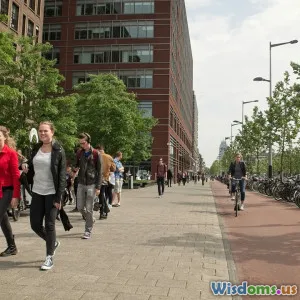
Why Safer Fast Baggage Handling Is Harder Than Expected
14 min read Explores the challenges and complexities behind achieving safer, faster baggage handling at airports. (0 Reviews)
Why Safer Fast Baggage Handling Is Harder Than Expected
Every time travelers step into an airport, swift and safe baggage handling is silently at work behind the scenes. The expectation is seamless delivery—bags checked, whisked away, and reliably appearing at their destination. Yet even as airports adopt ever faster and more high-tech systems, ensuring the safety of both baggage and baggage handlers remains unexpectedly complex. This journey into the world of baggage automation reveals it is much harder to achieve both speed and safety than most imagine.
The Physical Realities of Baggage Handling

At the heart of every airline journey is a mammoth, intricate dance. Have you ever glimpsed the backstage choreographies on baggage videos? Conveyor belts snake through airport labyrinths, bags zoom along rails, and staff must sort mountains of luggage with little margin for error.
Each bag can weigh as much as 70 pounds (32 kg). Multiply this by tens of thousands of bags per day at major hubs like Atlanta or Heathrow, and the intensity is clear. Fast handling is not just a goal, but an operational imperative; delayed bags mean unhappy customers and expensive claims for airlines. However, rushing naturally increases the risk of workplace injuries.
Worker Safety: The Problem Hidden in Plain Sight
Manual sorting and lifting account for a disproportionate number of musculoskeletal injuries. The U.S. Bureau of Labor Statistics reports that baggage handlers experience some of the highest injury rates among all airport staff. Back strains, arm sprains, and repetitive motion injuries are frequent due to hurried, awkward lifts and twists.
Major airlines have invested in ergonomic lifting devices, but introducing these slows down the process. Often, operational pressure means careful technique is sacrificed. Balancing fast bag delivery with worker safety is a daily struggle.
Automation: Promise and Limitations

Automation has powered remarkable gains in speed and reliability. Today’s airports feature high-speed conveyors, RFID tracking, and baggage sorting robots. For example, Hong Kong International Airport’s integrated automated baggage system can handle over 20,000 bags per hour, reducing turnaround time for planes and theoretically cutting down on human mishaps.
Yet, pure automation ushers in complications:
- Complex Layouts: Baggage handling spaces are often retrofitted into complex, rambling older terminals, making full robotic integration tricky.
- Exception Handling: Odd-sized items, broken suitcases, or bags tangled with tags still require human intervention, meaning humans and machines must work side by side in a crowded, fast-paced environment.
- Human Error Goes High-Tech: While machines don’t get tired, employees tasked with clearing jams or fixing sensors may have less time to follow full safety procedures during a breakdown.
Despite machines doing more lifting and transporting, people remain critical to resolving the exceptions that frequently arise in such a dynamic environment.
Security and Baggage Safety: A Delicate Balance

Making baggage systems safer isn't just about physical safety. The need for secure screening adds even more complexity to the race for speed.
Since 9/11, baggage is typically screened with high-tech scanners. Bags that trigger alarms are routed first for secondary screening, then back into the main system, introducing the possibility of mishandling or delays at every handoff. Coordinating multiple security layers with continuous flow is no easy feat.
Concrete example: When London Heathrow's new Terminal 5 opened, early teething problems with the automated screening system led to thousands of bags being misplaced—a situation partly due to breakdowns in the delicate choreography required among fast movement, accurate screening, and manual backup protocols.
Shortcuts to productive speed, whether skipping a double-check or bypassing a crowded checkpoint, compromise safety and can have severe consequences for airport security and public confidence.
Handling Mishaps: Cascading Effects of Minor Errors

One misplaced bag sets off an elaborate domino effect. Not only might the passenger’s trip be ruined, but locating and returning bags is costly. Statistics in 2023 from SITA show that worldwide mishandled bags cost the industry $$2.5 billion annually, and much of this stems from attempts to balance hectic workflows with (perceived) reasonable safety and efficiency.
Some mishaps result from rushing—bags that fall off conveyors may be tagged as lost, causing both liability and additional manual labor, often under unsafe conditions (lifting odd loads, climbing platforms). Other errors come from staff ignoring safety protocols due to time pressure.
Airports, therefore, must weigh every second gained by speed against a ripple of potential mistakes. The heavier the volume of traffic, the higher the stakes.
New Technology Isn’t a Panacea

The lure of high-tech fixes persists, from artificial intelligence predicting jams to smart RFID bags that self-report their positions. However, introducing new technology without reshaping processes often yields mixed results.
Practical Insight: The Problem of Unexpected Dynamics
Dallas/Fort Worth’s adoption of a state-of-the-art conveyor network suffered early on because seasoned workers weren’t fully trained, leading to a spike in errors as staff tried to troubleshoot unfamiliar jams. Maintenance teams, moved from reactive to proactive monitoring with digital dashboards, initially missed subtle, old-school warning signs—like subtle grinding noises—that sensors ignored.
Upgrades can even create new risks. Automation occasionally increases system speed beyond snowball effect sets in, overwhelming manual crew capacity at pinch points.
Key lesson: New tools, without well-aligned training and operating culture, can undermine the safety and predictability the system aims to enhance.
Regulatory and Financial Pressures

Aviation is highly regulated. To legally operate, airports must answer to numerous standards, from OSHA in the U.S. to European and international bodies, dictating staff safety, secure screening, and environmental noise limits.
Mid-sized airports may struggle to keep up. A financial outlay for faster, safer baggage systems can run into the tens of millions. Major upgrades, especially at older airports, are commonly delayed because ROI is notoriously slow, especially so when the direct benefits (fewer injuries, less lost baggage) are hard to calculate compared to the clear costs.
Unfortunately, shortcuts—whether in training, system upgrades, or safety protocols—are often a tempting way to “do more with less.” But these measures always rebound, whether in the form of safety violations, compensation lawsuits, public backlash, or regulatory penalties.
Fact: In the U.S. alone, baggage handler injury claims cost airlines over $100 million every year.
Rethinking Workflows: Continuous Improvement and Cultural Change

Rather than relying on a single fix—be it speedy machines or stricter protocols—the most successful airports invest in iterative improvements and a culture of safety that empowers fast pace without corner-cutting.
Example: Amsterdam Schiphol’s Approach
At Amsterdam Schiphol, management works closely with unions to design cycles of workflow review. Weekly team huddles allow baggage workers to suggest practical improvements—such as repositioning conveyor controls and breaking tasks into two-minute sprints with micro-breaks.
Fatigue management, regular health checks, and seasonal “surge” training—equipping staff for the busiest times—are all standard. As a result, Schiphol staff injury rates dropped 20% over four years, without reducing bag throughput, proving that an ongoing, human-centric improvement loop delivers sustainable results.
Tips for Safer, Faster Workflows
- Hold regular cross-team meetings to spot bottlenecks and gather ground-level feedback.
- Implement mandatory micro-rests in workflows, reducing injury chance while maintaining pace.
- Leverage data analytics from sensors to identify trends and correct them rapidly, but always add frontline staff perspective.
- Intrinsic safety culture—where reporting near-misses is seen as positive, not punitive—embeds awareness and improvement.
Practical Solutions: Bridging the Safety-Speed Gap

Safe, fast baggage handling requires innovation both large and small. A few principles stand out across the industry:
1. Ergonomics by Design
- Redesigned baggage carts and roller dollies with higher handles help reduce back injuries.
- Portable lifters and ramps reduce the need to manually hoist heavy bags high onto conveyor belts.
2. Predictive Maintenance & Smart Monitoring
- Sensors in high-wear areas alert staff to danger long before a jam puts staff at risk.
- AI systems forecast likely congestion points based on real-time check-in surges, triggering dynamic staff allocation.
3. Targeted, Ongoing Training
- Beyond initial onboarding, incorporating daily “red flag” briefings and scenario-based drills sharpens rapid, safe reactions.
- Gamified modules—where staff compete to spot the safest, most efficient handling method—have increased bending ergonomics compliance at some Asian hubs by 30%.
4. Designing For Exceptions, Not Average
- Allocating dedicated teams to rush or irregular items ensures the “normal” flow isn’t disrupted, lowering risk for everyone else.
- Clearly separated “red zones” for heavy bag handling, accentuated by luminous signage, keep unsafe activity away from fast-moving lines.
Looking Ahead: Is Safe Speed Truly Achievable?

Future baggage handling will blend next-generation automation, smarter analytics, and adaptable human teams. Already, pilot programs at Tokyo Haneda feature robotic exoskeletons for handlers, offering a glimpse into how human and machine can work together efficiently and safely.
Yet, no one-size-fits-all solution will exist. Each airport is unique—by layout, culture, budget, and passenger flow. Leaders in this space know that pairing technological innovation with a relentless commitment to holistic safety—operational, physical, and human-centric—ushers in real, repeatable results.
Air travel will always face stubborn complexities, but by unpacking the hidden challenges of baggage handling and addressing them head-on, the industry can one day achieve the elusive goal: moving everyone’s bags swiftly and securely to where they need to be.
Rate the Post
User Reviews
Other posts in Aviation & Air Travel
Popular Posts














